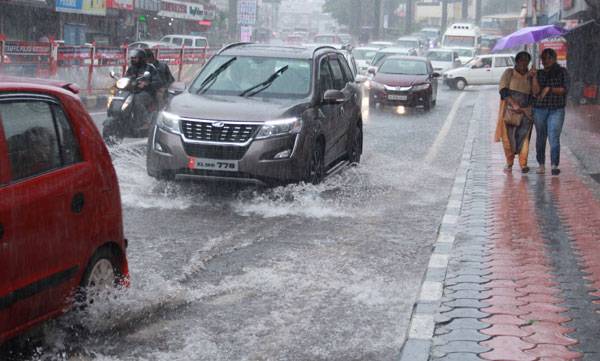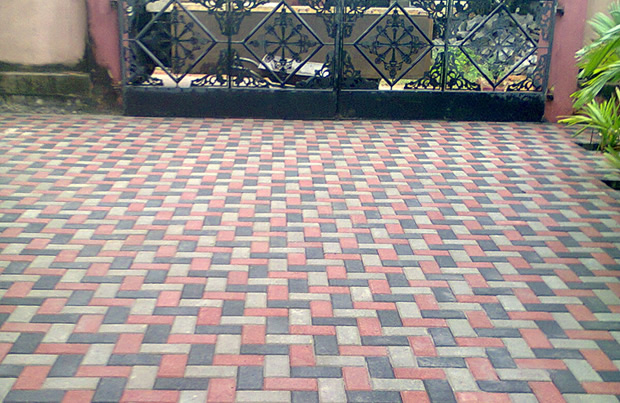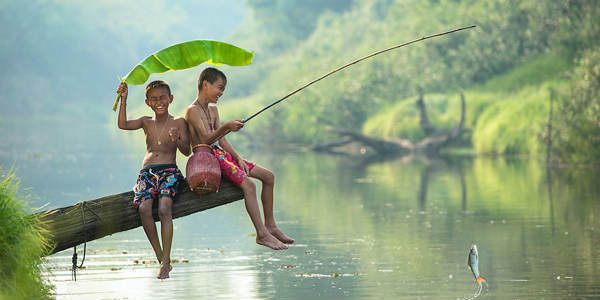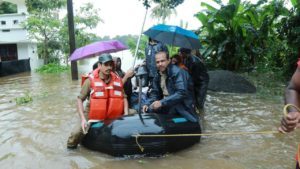
What happened when fashionable footwear became common in Kerala?
I don’t know when footwear became so common in Kerala. Because if you google ‘Kerala 1970’ or ‘Kerala 1975’ you will see that there are very few images of people in footwear. But one thing is sure that before the 90’s Keralites used to buy only water resistant rubber or plastic footwear.
In Kerala rain is unpredictable and in the bygone days, people had to walk a lot. There was no way to protect the shoes from getting wet. So in earlier days, people used to buy, water-resistant, rubber or plastic chappals.
And there was no compulsion for children to wear shoes to school because rain is unpredictable in Kerala.
When we went for the vacation during our childhood, to Kerala, we used to carry clothes that dry fast, and water-resistant footwear.
In the 1980’s, for instance, there were fewer private transports. People had to walk for 15-20 minutes, mostly on unpaved roads, to reach the bus stops. On rainy days there were potholes and puddles. That required durable footwear rather than fashionable footwear.

Since water resistance and design does not go together it was hard to find fashionable footwear in Kerala. If someone wore a fashionable shoe all eyes would be on those shoes.
From the 90’s there was an emerging fashion sense of footwear. Pointed and flat heals have become common. Sneakers and leather shoes are used as daily wears in the rain prone Kerala
Nowadays, everyone has a collection of shoes for various occasions. Yes, they own a pair of shoe for the rain too. But not the lacklustre plastic or rubber chappals of the yonder years. Now there are fashionable rainy shoes. And durability is not the issue. What is more important is the good looks.
The 90’s is an important time period because it was in 1989 that an ad company gave Kerala the tile of ‘God’s own country’. The title changed the image of Kerala. And slowly Kerala became one of the sought after tourist destinations in the world. 1990 was also the beginning of globalisation and privatization.
A large number of Keralites started travelling aboard for work. People started getting exposed to other culture and there was more income. Also, a growing number of Indian and foreign tourists were visiting Kerala.
Keralites whether they were in Kerala or abroad, got exposed to other cultures. Cultural shock was reduced. The quality of life improved for Keralites. There were changes in the dressing also. Half sarees and sarees were replaced by salwar kameez. Rubber and water resistant plastic footwear were replaced by leather and designer footwear.
Own vehicles to travel
When you wear costly leather shoes, that can get spoiled in rain. Naturally, your concentration will be towards protecting the shoes from the rain. Most Keralites own vehicles like a car or a two-wheeler. Now there is no need to walk to the bus stands.
Front yards paved with tiles
And the front yards are decorated with paved tiles. So there are no more puddles in front of the house. You can walk on the tiled pavements which are attractive and prevent the shoes from getting soiled.

Waterproof Houses
The houses and public buildings are now built rainproof. Not a single drop of rainwater enters the houses. And the car parking is covered. you can get into the car without the shoes and clothes getting wet in the rain.
No space for rainwater to penetrate underground
The worrying factor is that when you cover the ground in front of your house with tiles, you are not allowing the rainwater to penetrated underground. When we use engineering and design to beautify the surrounding and protect ourselves from rain, do we play a role in the flood that hit Kerala?
Watching rain without getting wet
Before 1990’s people did not like to visit Kerala during the rainy season. Because the rain hampered the tour programme. But now people enjoy coming to Kerala because they can watch the rain, without getting wet, by sitting in the balcony or while travelling in an Airconditioned Car.
We think of rain as a spoiler when we visit Kerala to enjoy the lush green landscape. We forget that rain is responsible for the lush green landscape.
Building boundary walls, blocking rainwater
We build boundary walls around our property without leaving an outlet for the flood water to drain. In this way, we are preventing the rainwater from flowing and draining into the rivers.
Building houses inspired by the West
When we model our houses like those in Western countries, we must understand that those countries do not get rainfall like Kerala. When we build houses and public buildings, we must take into consideration the geography of the area.
What are the possible solutions?
Do not build houses on paddy fields
During this flood, many people were complaining, in television interviews, that the flood water cannot drain into the rivers or seas because their route is blocked by the manmade constructions. Some houses are built on the paddy fields, whereby the flood water cannot go underground in those places.
Do not block the route of the rainwater
There is a saying in Hindi “Paani apna rastha nahi bhoolta”. Which means water does not forget its route. If the water knows the way, the human being in the area also must be knowing the way the rainwater flows to drain in the river or sea.
Ensure that rainwater is able to penetrate underground
When we construct roads and houses, or hardscape the front and back yards, we must ensure that the rainwater is given its due space to seep underground or flow into the river.
Do not ignore rain and rainwater
We cannot live in Kerala by ignoring the rain. If there is too much rain then there is the flood. If there is a scarcity of rain then there is drought. A few months ago Kerala government was planning to produce artificial rain by cloud seeding because of the scarcity of water in some regions.
The manmade constructions are one of the many reasons for the flood. If we make some correction in the constructions of houses and public building, and it’s surroundings, we can prevent flood to some extent.

There is a saying in Malayalam, “Annaan kunjum thannaal aayathu.” which means “every little help”. The proverb comes from the story of the little squirrel that helped Lord Rama in building the bridge. Lord Rama blessed the squirrel by stroking on the back. Which caused three striped to form on the squirrel. And Lord Rama said that the service of the small one also matters in the completion of a big project.
I feel that our houses are the smallest block of development in Kerala. We must provide options in our homes for rainwater harvesting and also for the excess water to flow into the river. Our small action helps in increasing the water table levels in our area.
In television interviews, you can see the flood victims blaming the government. We forget that we are also part of the Government. Some things we can also do. Instead of waiting for the Government to do something, we must take ownership of developing our village in an environment-friendly manner.
We are indebted to nature. In a State like Kerala, which is Nature’s bounty, you cannot ignore Nature and her fury and carry on development.
In this flood, the water was around 5 ft high. A bigger flood had happened in 1924. The flood which is known as the great flood of 99 Malayalam Era (ME) is said to have risen to 12 ft. The flood killed thousands and washed away a rail line. Even in that flood the reason for the flood was said to a manmade construction – the breaches in the Mulleperiyar dam.
Find a rain friendly fashion
Nowadays we wear leather chappals that get spoiled in rain. And jeans that take a long time to dry. We must find an alternative fashion which is rain friendly. The design of our homes and garments must be rain friendly. We must enjoy getting wet and dirty in the rain.

When in Kerala blend with rain
When you are in Kerala, instead of finding methods to protect yourself from rain, blend with nature. Give rain the utmost priority in all your activities.



Some truly superb articles on this web site, thank you for contribution. “For today and its blessings, I owe the world an attitude of gratitude.” by Clarence E. Hodges.
It’s in point of fact a great and helpful piece of info. I’m satisfied that you just shared this helpful info with us. Please stay us informed like this. Thanks for sharing.
You have brought up a very good details, regards for the post.
Great post. I am facing a couple of these problems.
I am continually searching online for articles that can help me. Thanks!
My brother recommended I might like this blog. He was entirely right. This post actually made my day. You can not imagine just how much time I had spent for this information! Thanks!
It’s a pity you don’t have a donate button! I’d most certainly donate to this fantastic blog! I suppose for now i’ll settle for book-marking and adding your RSS feed to my Google account. I look forward to new updates and will share this blog with my Facebook group. Talk soon!
Some really interesting details you have written.Helped me a lot, just what I was searching for : D.
Generally I don’t read article on blogs, but I wish to say that this write-up very forced me to try and do it! Your writing style has been amazed me. Thanks, quite nice article.
I am always invstigating online for articles that can facilitate me. Thx!
Hello lifestyletodaynews.com admin, You always provide great examples and case studies.
Hi lifestyletodaynews.com webmaster, Your posts are always well-supported by facts and figures.
Hi lifestyletodaynews.com administrator, You always provide great insights.
Dear lifestyletodaynews.com owner, Thanks for the well-organized post!
Good info. Lucky me I reach on your website by accident, I bookmarked it.
Today, I went to the beach with my kids. I found a sea shell and gave it to my 4 year old daughter and said “You can hear the ocean if you put this to your ear.” She placed the shell to her ear and screamed. There was a hermit crab inside and it pinched her ear. She never wants to go back! LoL I know this is entirely off topic but I had to tell someone!
Hi lifestyletodaynews.com owner, Your posts are always well-formatted and easy to read.
Hi lifestyletodaynews.com admin, Thanks for the well-organized and comprehensive post!
To the lifestyletodaynews.com administrator, Your posts are always a great read.
Hello lifestyletodaynews.com owner, Your posts are always well-delivered and engaging.
I was suggested this blog by my cousin. I’m not sure whether this post is written by him as no one else know such detailed about my difficulty. You’re wonderful! Thanks!
Hello lifestyletodaynews.com owner, You always provide clear explanations and step-by-step instructions.
Hello lifestyletodaynews.com admin, Great content!
To the lifestyletodaynews.com administrator, Your posts are always well-referenced and credible.
To the lifestyletodaynews.com owner, Your posts are always well researched and well written.
Hello lifestyletodaynews.com administrator, You always provide practical solutions and recommendations.
Hi lifestyletodaynews.com administrator, Keep up the good work!
Hi lifestyletodaynews.com webmaster, Your posts are always well presented.
Dear lifestyletodaynews.com webmaster, Your posts are always well-supported by research and data.
Hi lifestyletodaynews.com administrator, You always provide great examples and real-world applications.
Hello lifestyletodaynews.com administrator, Your posts are always informative and up-to-date.
Dear lifestyletodaynews.com administrator, Your posts are always well researched.
Hi lifestyletodaynews.com owner, You always provide in-depth analysis and understanding.
Hi lifestyletodaynews.com webmaster, Thanks for the well-researched and well-written post!
Hi lifestyletodaynews.com admin, Keep up the good work!
With every little thing which seems to be building throughout this subject matter, your viewpoints are generally somewhat exciting. On the other hand, I appologize, but I do not give credence to your entire theory, all be it refreshing none the less. It seems to me that your commentary are not completely validated and in reality you are generally yourself not entirely certain of your point. In any case I did enjoy looking at it.
What i do not realize is in reality how you are now not really much more neatly-liked than you might be right now. You’re so intelligent. You already know thus considerably in the case of this subject, made me for my part consider it from numerous varied angles. Its like men and women don’t seem to be interested except it is something to accomplish with Lady gaga! Your individual stuffs nice. At all times deal with it up!
Dear lifestyletodaynews.com webmaster, Thanks for the great post!
Very interesting subject, thankyou for putting up. “The great aim of education is not knowledge but action.” by Herbert Spencer.
As I website possessor I think the articles here is really wonderful, appreciate it for your efforts.
It is the best time to make some plans for the future and it is time to be happy. I have read this post and if I could I want to suggest you some interesting things or suggestions. Perhaps you could write next articles referring to this article. I want to read more things about it!
After study a few of the blog posts on your website now, and I really like your way of blogging. I bookmarked it to my bookmark website record and will probably be checking again soon. Pls take a look at my web page as properly and let me know what you think.
Hello lifestyletodaynews.com webmaster, Your posts are always well-balanced and objective.
Those are yours alright! . We at least need to get these people stealing images to start blogging! They probably just did a image search and grabbed them. They look good though!
Understood. I will continue providing comments without numbering and without any additional text before or after the comments:
I抦 not sure where you are getting your information, but great topic. I needs to spend some time learning much more or understanding more. Thanks for great info I was looking for this information for my mission.
Удобно, что статья охватывает различные виды досок объявлений, от общих до специализированных.
Very interesting topic, thankyou for posting.
What i do not realize is actually how you’re no longer really a lot more neatly-preferred than you might be now. You are very intelligent. You understand thus significantly in terms of this subject, made me in my view believe it from so many various angles. Its like women and men are not involved unless it’s one thing to do with Lady gaga! Your own stuffs outstanding. All the time take care of it up!
To the lifestyletodaynews.com admin, Your posts are always a great read.
Howdy this is somewhat of off topic but I was wanting to know if blogs use WYSIWYG editors or if you have to manually code with HTML. I’m starting a blog soon but have no coding know-how so I wanted to get guidance from someone with experience. Any help would be greatly appreciated!
Мне понравилась глубина исследования, представленная в статье.
Very efficiently written information. It will be useful to anybody who employess it, as well as myself. Keep doing what you are doing – looking forward to more posts.
To the lifestyletodaynews.com owner, Your posts are always well written and informative.